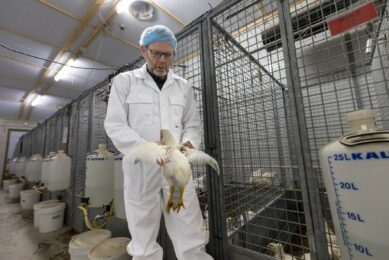UV light lowers Tibial Dischondroplasia in broilers
Broiler welfare is always a delicate subject with lameness a particularly evocative issue. New research could hold the key to almost eradicating lameness in broiler flocks.
The study, carried out by the Roslin Institute in Scotland, examined the link between vitamin D deficiency and leg weakness.
It particularly concentrated on Tibial Dischondorplasia (TD), a syndrome in which distorted bone growth leads to impaired gait and consequently welfare.
“Lameness in birds has been an industry problem for a long time,” says research scientist Bob Fleming. “TD is often the initial problem and deformities follow on from that, which lead to lameness or an inability to walk at all.”
Although nutrition and breed are contributing factors to the incidence of TD, deficiency in vitamin D is another important element, he says.
“Vitamin D improves calcium uptake in the gut, and has other interactions with calcium and phosphorus and the mineralisation of the bone growth plate.”
“Feeding levels of vitamin D3 considerably above the current legal limit can prevent TD, but it is a toxic additive,” says Fleming.
UV light and vitamin D
Vitamin D is also produced in the skin when exposed to UV light – naturally occurring in sunlight. “In modern broiler production birds have little or no exposure to light in the UV wavelength,” he adds.
“The use of UV lighting may thus provide an opportunity to boost vitamin D3 levels in young broiler chicks.”
Experiment
The research team set up an experiment with 60 one-day old Ross broiler chicks, which were split between a control environment and a shed featuring UV lamps.
“We used compact fluorescent tubes which can be used in ordinary poultry lighting units,” says Fleming.
The chicks were exposed to UV light for 12 hours after placement, with lighting in both the control and test sheds maintained at the same overall luminance.
After that the UV lamps were switched off, returning the birds to exactly the same conditions as the control group. “If you continuously expose them to UV there is a greater danger of eye problems and keratitis, or sunburn.”
Both groups were fed a slightly unbalanced diet, low in calcium and phosphorus, to increase the chances of TD appearing. Vitamin D levels in the blood were measured daily, and the chicks were slaughtered at 14 days old to analyse their bone structure.
Remarkable results
The results were remarkable. Just 2% of the treated broiler chicks displayed signs of TD, with 98% having normal bone growth plates.
That compares to just 43% of normal growth in the control group, with 39% having rickets – possibly an early indicator of TD – and 18% showing TD lesions.
The treated birds were 6% heavier than the control group, and displayed significantly stronger, more resilient and healthier tibia (leg) bones than the control flock.
“They have obviously thrived due to having UV illumination.” Blood vitamin D levels were also significantly higher throughout the test.
Budgets are tight at Roslin Institue. “We want to take it to the next stage and it would be a great future project. It needs to be done on a commercial scale now and fortunately we have had some interest,” Fleming says.
With UV lighting getting cheaper all the time, there are fantastic opportunities to implement UV lighting systems in commercial broiler flocks, he adds.
“Birds are often culled if they have TD lesions – this way the industry will have to cull less birds.”
Join 31,000+ subscribers
Subscribe to our newsletter to stay updated about all the need-to-know content in the poultry sector, three times a week. Beheer
Beheer








 WP Admin
WP Admin  Bewerk bericht
Bewerk bericht